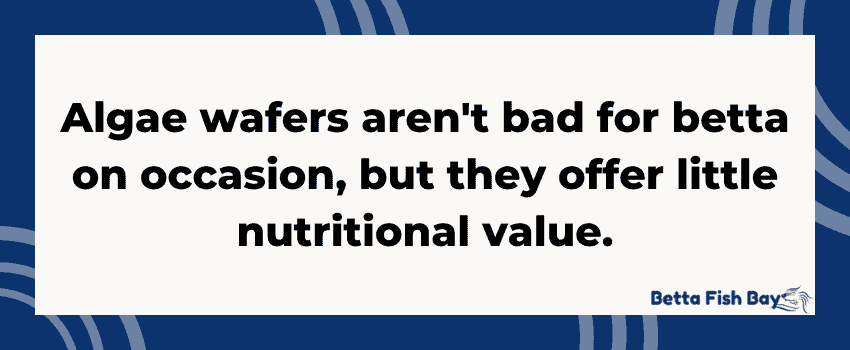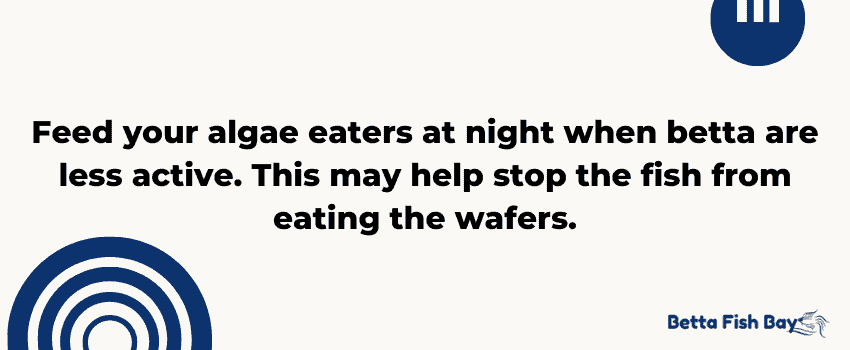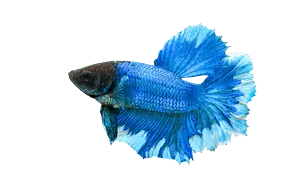Algae eaters like snails and shrimp are wonderful for your betta fish tank.
They mostly subsist on algae and the plant, fish, and food waste in the aquarium.
But when you supplement their diet with an algae wafer, you might notice your betta wants a bite!
To discourage your betta from eating algae wafers, feed them shrimp pellets at the same time you feed your algae eaters. Another solution is to drop the wafers in at night after the tank lights go off. If all else fails, float your betta in a breeding box while your other pets eat up those algae wafers.

Table of Contents
Why Your Betta Wants Algae Wafers
To stop your betta from eating algae wafers, you need to figure out why they’re doing it in the first place.
There are a few possible reasons:
- Underfeeding
- Greed/territorial
- Wafer ingredients
Betta fish need two meals a day. Many people give their betta one fasting day per week.
At each meal, your betta gets two to three pellets. We recommend supplementing with live and frozen foods.
This helps them get a variety of nutrients, and it makes mealtime more exciting!
Your betta is less likely to go after your algae eaters’ food if they are satisfied with their own.
However, they may simply be gluttonous fish.
Many betta fish are territorial and like to lay claim over their space.
They often do this by flaring or nipping at other creatures who come too close.
But they may also go so far as to take food from their tank mates.
Algae wafers are not particularly enticing to a betta. They prefer shrimp and other meaty snacks.
But if they don’t like having tank mates, they might take matters into their own fins. (See what I did there?)
Finally, take a look at the contents of those algae wafers. Some of these wafers have fish meal or other fish foods in them.
Look for 100 percent plant-based algae wafers to feed your snails or shrimp.
Here’s a vegetarian option we recommend.
This way, your siamese fighting fish won’t smell betta fish feed in the wafer and steal it!
Are Algae Wafers a Safe Food for Betta Fish?

It’s okay for your betta to eat them sometimes, but algae wafers are not nutritious for your pet.
Betta fish are primarily carnivorous.
They may eat the occasional pea to help with digestion (though we recommend different treatments for bloat/constipation).
Otherwise, they stick to shrimp, daphnia, and other protein-heavy foods. This is very important for their health.
Algae is occasionally okay, but it won’t do them any good in the long term.
This is especially true if they have less appetite for their own meals.
Seeing your betta eat a wafer occasionally is not a huge cause for concern. But if you notice a pattern developing, it’s time to step in.
Too much algae cause digestive issues in betta fish.
This could turn into constipation, bloat, or Swim Bladder Disease (SBD) if you don’t address it immediately.
Teaching Your Betta Not to Eat Algae Wafers
Maybe your betta eats a wafer from time to time. But if you notice them doing this more regularly, you must do something.
Here are some simple ways to fix the problem:
- Feed betta and algae-eaters together
- Use a floating breeding box
- Feed algae wafers at night
- Divide tank
Simultaneous Feeding
The best solution is to simply feed your mischievous betta at the same time as your snails.
They will probably have eyes only for their fish pellets!
This allows your algae eaters to enjoy their own food in peace.
Your betta should only eat as much as they can finish in about five minutes.
They will most likely be satisfied, having just barely eaten.
But if they don’t like their tank mates and are adamant about stealing their food, they will do it.
Algae eaters tend to be slow in eating their food. So if your betta is determined to steal their meal, this may not be enough of a solution for you.
Floating Breeding Box
Floating breeding boxes are pretty easy to find at pet stores and online. Here’s a popular one available on Amazon.
These are great because they help you separate your fish without much hassle.
Get your betta in the breeding box when it’s time to feed your bottom feeders.
The breeding box lets them stay in the cycled tank water without stealing those algae wafers.
You don’t want to leave them in the breeding box too long.
This is a temporary solution for when your bottom feeders are actively eating their algae wafers.
If the problem continues, change the schedule to see if it helps.
Feeding Your Snails in the Dead of Night

Your betta most likely has a semi-regular sleep schedule. Whether you use a tank light on a timer or control it manually, they sleep around the same time each night.
Once the tank is nice and dark, drop an algae wafer in the tank.
Your betta is unlikely to pay it any mind.
Your snails, on the other, will be happy to munch in the dark.
Who doesn’t love a midnight snack? Well… betta fish, I suppose.
But algae eaters are totally into it, so it just might work!
This is one of those last attempts at finding a harmonious solution. It may be time to separate your betta and their tank mates if all else fails.
Separation
Most of the time, algae eaters don’t even need the supplement of an algae wafer.
For this reason, we recommend giving all the other solutions a go before separating your pets.
But if nothing works, you need to move your snails or shrimp out of the aquarium.
Your fish simply cannot keep eating algae. It’ll make them sick over time.
Whether you use a tank divider (tank must be bigger than five gallons) or two separate tanks is up to you.
Betta Fish Just Wanna Have Lunch
Giving algae wafers to your bottom feeders is tricky when you have a betta.
All bets are off if your betta is underfed, greedy, or smells fish feed. Algae wafers are not a safe treat for them to eat consistently.
To keep them away from your algae eaters’ treats, feed your betta pellets or frozen food at the same time.
Say this doesn’t work: you may need to use a floating breeding box or separate them another way.
Keeping snails with your betta? Here’s a comprehensive guide on how to keep things peaceful, including feeding time!


